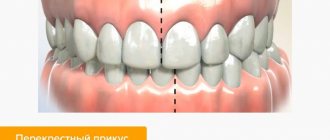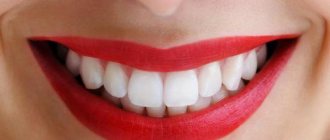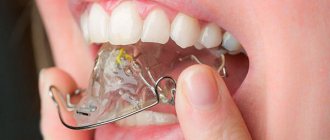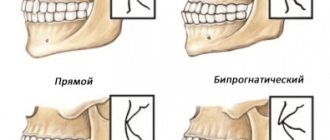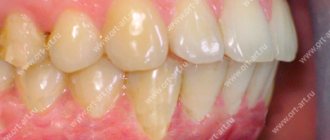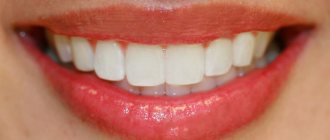Most orthodontic problems begin due to improper jaw development. The child’s myofunctional habits lead to malocclusion. Crooked teeth are difficult to clean properly and can ruin your smile. In hard-to-reach areas where the brush cannot reach, tartar forms, which leads to caries and sometimes to periodontitis. The unevenness affects the mandibular joint.
Correcting crooked teeth can be done not only in childhood or adolescence. In the Propricus network of clinics, appointments are conducted by orthopedic dentists and orthodontists, who have been restoring a beautiful smile to patients for many years. The clinic's doctors develop an orthodontic treatment plan for each patient. This problem can and should be dealt with by both adults and children. The sooner treatment begins, the better.
Why do teeth grow crooked?
Often children inherit not the best traits of their parents. If parents have a similar problem, the anomaly is likely to be passed on to the child. In addition to genetic predisposition, the deformity is provoked by a lack of vitamins and microelements in the diet of the expectant mother. The lack of solid food in the baby's menu, frequent mouth breathing, congenital anomalies - all this affects the formation of the dentition.
One of the common causes of malocclusion is thumb sucking in childhood. At school age, the child switches to sucking pens, pencils, and begins to bite his nails. Injuries and poor oral hygiene can also cause crooked teeth. Early loss of baby teeth can lead to crooked permanent teeth.
Problems with wisdom teeth
Initially, the dentition may be straight. If your dentist notices that it has started to become crooked, wisdom teeth may be the cause. Third molars displace adjacent teeth. But even after their removal, the dentition will no longer straighten on its own.
Often the eruption of eights occurs at the age of 20-25. If they have nowhere to erupt, they move their neighbors who are located in front. If before the appearance of figure eights the dentition was straight, then after their appearance orthodontic treatment may be necessary.
At a consultation appointment in our clinic, the doctor will assess the condition of the oral cavity. If necessary, he will remove third molars under anesthesia. You will not feel pain or discomfort. If you're self-conscious about your smile, it's time to make an appointment with an orthodontist.
Need some advice?
Enter your phone number and we will give you a free consultation
I want a consultation
*By making an appointment you consent to the processing of your data
Loss of teeth
When removed, teeth tend to fill the void and take up free space. By bending and moving, they create the basis for the improper development of others. This causes crowding.
In this case, the permanent tooth, which no longer has a place where it should erupt, follows the path of least resistance. He takes a place that is convenient for him. The cause of abnormalities in adults is injury. Under the chewing load, the dentition constantly shifts towards an empty space. Even if your bite was perfect before, in this situation it will deteriorate.
Underdeveloped dental system
The distant ancestors of mankind had no problems with the dental system. This is because they ate solid food that was not thermally processed. Due to the fact that people now eat freeze-dried food, the dental system does not develop as it should. As a result, the number of teeth remains the same, and the jaws do not fully develop.
This leads to crowding and the development of malocclusions. A person should eat solid food from childhood. Prolonged sucking of pacifiers negatively affects the formation of the dentition system.
How to straighten teeth for an adult
If you think that an overbite is just unsightly, then you are mistaken. The anomaly is dangerous due to the uneven distribution of the chewing load. When chewing food, not only the dentition, but also the joints collapse.
To stay healthy and look good, you should not delay orthodontic treatment. Our clinic’s orthodontists install correction systems for patients of any age. The doctor, together with the patient, selects the correction method.
Basic methods of orthodontic treatment in adults:
Fixed structures
The most common correction method is to correct the bite using a braces system. They help correct pathologies of varying degrees. Even the heaviest ones. Fixed structures successfully cope with problems of the oral cavity, both physiological and aesthetic.
Our clinic uses different types of structures. For example, lingual or sapphire vestibular braces can be installed on the upper jaw. Visually they are invisible.
Combined treatment
If there are severe skeletal disorders and bite deformities, then the professional knowledge and skills of an orthodontist and surgeon are required. Doctors create a comprehensive treatment plan, which includes jaw surgery and correction with braces.
Correction with aligners, veneers, lumineers
Veneers are used to correct the anterior row. The downside of the structures is the need to grind down your own healthy teeth. Lumineers fit tighter and look more natural. There is no longer any need to endure discomfort from braces. Aligners are used to correct simple dental anomalies. They are smooth, transparent, and cannot be seen. This gentle correction method can completely replace braces.
The result of treatment does not depend on age. An experienced orthodontist will make your smile perfect, no matter your age. At the Propricus clinic they know everything about how to correct crooked teeth without pain. During the consultation, the doctor will select possible treatment options and tell you about the duration of the correction. Next, the decision is yours.
Sign up for free 3D modeling of your future smile!
Make an appointment
*By making an appointment you consent to the processing of your data
Installation Features
Before installing veneers, the dentist must tell the patient how the procedure will work. Reconstruction cannot be done in one visit. The duration of recovery depends on the number of teeth.
Procedure steps:
- examination of teeth and selection of material according to individual characteristics (material, color, shape, etc.);
- tooth treatment (removal of top enamel);
- creating an impression for making a plate;
- overlay of temporary veneers;
- removal of temporary overlays and installation of manufactured plates.
Among all the advantages, installing veneers has a disadvantage - possible grinding of the natural crown. This is necessary to align the crown in relation to other teeth. If this procedure is required, the doctor must warn the patient in advance.
How to straighten a child's teeth
In modern orthopedic dentistry, several methods are used to correct dental anomalies in children. You should contact an orthodontist at the age of 3-4 years. The doctor will be able to recognize abnormalities if they exist. An abnormal bite is treated by keeping the teeth in the correct position.
Braces are often used for correction. Special orthodontic locks are glued to the enamel surface and secured with an arch. They gradually shift the dentition into the correct position.
Also used:
- Trainers are the most gentle method, they are made of silicone and are put on both jaws. If you use trainers daily, the treatment period is up to 1.5 years;
- plates that correct bite - there are removable and non-removable plates; they are made of plastic with metal wire inserts; removable structures can be removed during meals and oral hygiene.
During the consultation, the orthodontist determines the possibility of straightening without braces. Alternative methods can be used when the patient is allergic to metal, when the gums are low, the whole row is not curved, that is, only 1-2 teeth are incorrectly positioned. Aligners cope with almost all occlusion defects. They allow treatment to be carried out comfortably and quickly.
Which doctor installs braces?
The procedure for installing braces is the responsibility of an orthodontist. It helps restore a person’s attractive and beautiful smile. Not every dental clinic has such specialists. Therefore, if he is not on the hospital staff, treatment can be carried out by an ordinary dentist who has undergone specialized training.
The need for specialists in this area has arisen relatively recently. Previously, dental therapists were involved in the treatment of dental defects. It was not always possible to obtain the desired result. Therefore, the need for retraining arose. Today, a specialist called an orthodontist treats not only problems with crooked teeth, but also other dental diseases.
The effectiveness of correcting malocclusion primarily depends on the qualifications of the doctor, the quality of the material and equipment used. It is important that he makes the correct diagnosis and identifies the cause of the curvature of the dentition. Only in this case can you choose the necessary design that will help correct the bite.
Braces are placed not only on young people, but also on older people. For the latter category of people, it is very important to find an experienced doctor who installs braces. He must carefully select the design and determine the treatment regimen: duration of wearing braces, frequency of visits to tighten the arch of braces. If the choice of a specialist is made incorrectly, then you should not count on a highly effective result.
It is very important that the doctor who installs braces has not only professional, but also personal qualities. He must be sociable, personable, and also partly a psychologist. All this together will help to select the optimal treatment regimen for a person with dental defects.
How to straighten teeth with braces
Braces are installed in stages. Preparation and diagnosis are especially important. The doctor conducts an examination, comprehensive diagnostics, and makes impressions of both jaws. At the first stage, contraindications to the procedure are determined. If there are no restrictions, then the dentist performs sanitation of the oral cavity. Professional cleaning and treatment of carious teeth is a prerequisite before fixing structures.
When installing sapphire or ceramic braces, you must first whiten your teeth. The corrective action is carried out due to external pressure. The main role is assigned to the rigid arc. Therefore, doctors regularly replace one arch with another. Depending on the complexity of the deformity, correction takes up to 1.5 years.
Types of bracket systems:
- metal - suitable for the most severe deformities; metal clasps provide more intense pressure, which reduces the duration of correction;
- ceramic - made of polymer based on aluminum oxide, due to this the systems are transparent and invisible;
- sapphire - made from a mineral that is grown under artificial conditions, such systems are hypoallergenic, durable, and resistant to coloring from food dyes.
Installing braces at the Propricus clinic will relieve you of pathologies of the dental system. Dental doctors begin treatment only after a comprehensive diagnosis. All changes and nuances are agreed with the patient. If any contraindications are found, the doctor will suggest you the most appropriate treatment.
When choosing sapphire models, keep in mind that this is the most expensive treatment. Metal systems are the most affordable correction method. To reduce costs, choose a turnkey braces installation service.
Why should I contact an orthodontist?
The competence of an orthodontist includes:
- malocclusion of any stage - from minor defects to complex congenital pathologies with the use of surgical interventions;
- impaired tooth growth;
- dental and jaw curvature;
- the presence of interdental spaces or, conversely, crowding;
- anomalies in the position of the dental arches;
- speaking and chewing dysfunction;
- facial asymmetry.
Important! Some deviations in the normal structure of the jaw and the position of the teeth can lead to difficulty breathing. This problem is also solved by an orthodontist.
Thus, orthodontists solve not only the aesthetic issue of a smile, but also take care of the vital functions of the patient’s body.
When is an orthodontist needed?
The “dental issue” should not be shelved, since any deformation over time worsens the condition of the maxillofacial apparatus, which affects the standard of living.
Parents should include an orthodontic examination at the age of 3 years for a preventive examination and early detection of pathologies.
Warning signs that you need to contact a specialist are:
- presence of bad habits - sucking a pacifier or thumb, chewing a pencil, etc.;
At the age of 6 years, it is necessary to see an orthodontist, especially if:
- there are problems breathing through the nose, and the child breathes through the mouth most of the time;
- the presence of changes in the jaw, including abnormal growth, curvature, crowding or sparseness.
However, not everyone has the financial, time and psychological opportunity to deal with pathologies in childhood or adolescence.
Therefore, orthodontic issues (even surgical ones) can be addressed at any age. The main thing is to find a good specialist.
How does an orthodontist treat?
Let's imagine you found a doctor based on reviews from friends, or via the Internet, or thanks to advertising. And now get ready for your first appointment.
Of course, no one will put on braces at the first meeting. Initially, the patient needs to have a detailed X-ray of both jaws.
Note! Three-dimensional CT examination can also be used.
An orthopantomogram is a computerized circular image of the jaw “in a spread” - in addition to teeth, roots, canals and crowns with fillings, it is used to evaluate the level of bone tissue, the temporomandibular joint, and the maxillary sinuses.
This image allows you to identify inflammatory processes (caries, cysts, pulpitis, periodontitis), which must be eliminated before starting treatment, otherwise the period of exacerbation will disrupt the course of treatment.
After the photographs taken, a consultation with an orthodontist follows, who will suggest possible ways to solve the problem.
Clinical and functional diagnostics
Modern clinics use an integrated approach, which consists of a detailed study of teeth and the structural features of the bite.
Diagnostics includes the following steps:
- Initial consultation with an oral interview and identification of the occlusal index (pathology in the closure and position of the jaws);
- Palpation of the jaw joint, muscle composition in the neck, head, possibly in the oral cavity;
- Production of an occlusiogram based on the studies carried out, which can be used to determine the level of closure, if necessary, study of the type of teeth grinding - bruxchecker;
- The use of an articulator is a model for simulating the dental system in order to understand how long it will take for complete healing;
- If there are problems with the jaw bones (clicking), diagnosis is carried out using axiography.
Myotherapy
This method is used for the youngest patients with temporary dentition (that is, when baby teeth have not yet been replaced by molars).
In fact, myotherapy is a set of gymnastic exercises for the oral cavity that can be performed from the age of four, under the direct supervision of adults.
Exercises include dynamic (contraction and relaxation of the muscles of the lips, cheeks and tongue) and static load.
The basic rules of myogymnastics are:
- systematic implementation;
- suitable load (it is important that after the exercises the child gets a little tired);
- constant monitoring of increasing load so as not to overdo it;
- the time and amount of exercise should increase.
Myotherapy is used where corrective structures cannot yet be installed, or in adults after brace treatment, to maintain the achieved effect.
Hardware method
The classic tool of the orthodontist is braces.
Bracket systems, which are attached to a special adhesive that does not damage the tooth enamel, are connected using a thin fishing line. Over time, the line is tightened to gradually straighten the teeth.
The invention of virtually invisible structures made of ceramics or internal braces allows patients to forget about constraint. Therefore, more and more adult patients can be seen correcting their smile.
Wearing braces leads to a number of inconveniences:
- high cost - even a classic visible system for one jaw with all maintenance visits will cost at least one hundred thousand rubles;
- pain is present, since interference with the usual order of the teeth causes the row to move, causing pain and inconvenience in the first weeks of wear;
- thorough hygiene - you can no longer brush your teeth in five minutes; special brushes, brushes, irrigators and rinses become the best friends of those with braces;
- Duration of treatment - depending on the degree of pathology, treatment can take up to two years.
In addition to classic braces, you can choose aligners - transparent trays for straightening minor deviations from the norm.
They can be removed while brushing your teeth and eating, which greatly simplifies the care of the system, but requires a conscious attitude.
Operation
Sometimes, the problem requires a radical solution in the form of intervention by a maxillofacial surgeon:
- an incision is required in the oral mucosa to artificially expand the dentition;
- augmentation or filing of the jawbone to correct facial asymmetry.
Then the maxillofacial surgeon, together with the orthodontist, guarantees a noticeable effect in the aesthetics of the smile and appearance.
This solution to an orthodontic problem is typical for serious anomalies.
How to straighten teeth without braces
Patients are often reluctant to get braces due to the long treatment period and the visual appeal of iron clasps. Bite correction using aligners has become a very popular procedure.
Aligners are trays made of transparent and elastic material that are applied to the entire dentition. The patient can take them off and put them on independently. The principle of their influence is imperceptible, gradual pressure on the teeth. This points them in the right direction. The material does not injure the gums, mucous membranes, enamel, and does not cause allergies.
At a consultation appointment at the Propricus clinic, the doctor will tell you in detail about this treatment. During the entire treatment period, the patient is given several sets of mouth guards. Aligners are prescribed if crowding or large gaps are diagnosed, if the jaw moves forward.
Before correcting a crooked tooth with mouth guards, you also need to sanitize your mouth. The aligners themselves can be cleaned with toothpaste and a toothbrush. There are no food restrictions. The only thing is that you need to remove the aligners before eating and then rinse your mouth.
Ways to straighten teeth without braces
You can straighten your teeth and correct your bite using aligners, trainers, plates, elastopositioners, veneers and composite restorations.
Aligners
These are clear trays made of dental silicone or plastic that are placed over the teeth. They have a number of advantages over other orthodontic structures:
· thanks to the transparency of the material, they are completely invisible when worn;
· if necessary, they can be easily removed;
· patients quickly get used to them;
· do not cause discomfort when worn and do not injure the mucous membrane;
· made of hypoallergenic and non-toxic material;
· do not complicate daily oral care;
· do not require a special diet;
· reasonable cost of structures.
To achieve a therapeutic effect, you need to wear aligners at least 22 hours a day. That is, they can only be removed while eating and before performing hygiene procedures.
Trainers
These designs are similar to aligners and are an alternative treatment option. Trainers are made from soft silicone or polyurethane. Adults are recommended to wear them to correct minor dysfunctions of the jaw apparatus, and these silicone splints need to be worn only at night, immediately before bed, and also during the day for several hours. Aligners, or aesthetic aligners, must be worn around the clock and for quite a long time. In addition, they must be replaced every two weeks with the next model.
Since treatment with trainers takes place in three stages, there are several types of structures
:
· blue splints are preparatory and have a gentle effect on the jaw;
· hard pink trainers put more pressure on the dentition; they begin to be worn at the second stage of treatment and only after the jaw is completely prepared;
· at the third and final stage of correction of defects, patients wear retainers to consolidate the results obtained.
Trainers, like aligners, have their own advantages, the main ones:
· wear only a few hours a day;
· relatively low price of the structure.
Despite the fact that trainers are most often produced in different colors, for adults these designs can be made transparent so that they do not attract the attention of others and do not provoke psychological discomfort in patients.
Veneers
These are special overlays for teeth made of ceramics. They are used in cases where the patient only wants to visually eliminate defects, and not undergo full treatment to straighten the teeth or correct the bite. Veneers are especially often used to hide diastemas.
Composite restoration
This is a unique alternative to veneers; only onlays made of composite materials are used to visually correct defects. This service is low cost. However, it has several disadvantages - linings made from filling materials can absorb food coloring and, as a result, change their shade. In addition, their lifespan is quite short and the strength is relatively low, so the patient must visit the dentist regularly to have these onlays adjusted.
Records
They help correct the position of one or two teeth, eliminate diastema and crowding. The design consists of a plastic base and titanium arches that tightly cover the teeth requiring correction.
It is inexpensive and relatively comfortable. However, it requires round-the-clock wearing and careful care. The duration of treatment depends on the age of the patient.
Elastic positioners
In appearance they resemble mouth guards. They are made by high-temperature vulcanization from transparent hypoallergenic A-silicone Silasto using the Set-up method. They have excellent biocompatibility and a high degree of transparency. They are used to correct bites, straighten teeth and as retainers to consolidate the therapeutic effect. Due to the special properties of the material, only one positioner is needed for the entire course.
Who are aligners suitable for?
In their work, the clinic’s doctors use aligners from the American company Invisalign. They are made of safe polymer and are absolutely safe for the body. The mouthguards are comfortable to wear and effective. The results of Invisalign treatment are comparable to the use of braces. They cope with all malocclusions. Aligners are installed for all patients, regardless of how old the patient is.
The main rule for successful treatment is to wear a mouthguard at least 20 hours a day. Propricus dentistry has everything you need to carry out orthodontic treatment by any method.
Do you want to correct your bite? We are waiting for you at the PROPRICUS clinic!
- The leading expert of the clinic, Nana Gezalova, is doctor No. 1 in the Invisalign rating. This is a talented orthodontist with 15 years of experience and extensive experience working with Invisalign aligners. She personally trains the clinic’s orthodontists and strictly controls the quality of treatment for each patient.
- We never change the cost of treatment after signing the contract. The price of treatment does not increase, even if the dollar exchange rate has changed.
- The clinic’s specialists continuously improve their knowledge and skills, participate in international conferences, and communicate with foreign colleagues.
- We use advanced equipment and regularly update our technical fleet.
- We don’t just straighten teeth, but work comprehensively to ensure healthy jaw joints, correct bite and high aesthetics.
Features of the orthodontist's work
When seeing a patient, the doctor needs to explain to him the purpose of wearing braces and how this will affect changes in the bite. On average, an orthodontist manages to see up to 13 people in one working day. One appointment takes approximately 30 minutes.
Treatment with braces takes place in 2 stages. At the first stage, the doctor makes a diagnosis and installs correction devices. At the next stage, it is secured by installing mouthguards or retainers on the inside of the teeth, which resist displacement of the bite.
For each situation, the doctor needs to choose the appropriate design. Braces differ in the method of fastening, the principle of influence and appearance.
Types of bites can be different. Let's consider the main ones:
- hereditary, passed on from parents to their children. Bite defects in this case are combined with the presence of additional teeth, diastema and trema. When diagnosing, there is a need for additional procedures;
- congenital, when disorders occurred already during the development of the fetus. Then, after birth and adulthood, dental defects or lack thereof are observed. This complex type of bite is a job for an experienced orthodontist;
- acquired, arising years after birth. It can be recognized at an early stage of its appearance, so treatment is more effective and does not take much time.
Today, an orthodontist in cities can be found in both private and city dentistry. Therefore, people with malocclusion can easily be helped by a qualified doctor who can correct defects and make their smile attractive.
An orthodontist who is popular among patients usually has human qualities in addition to professional ones. He is tolerant, sociable, efficient and friendly. Also, a good orthodontist must be a psychologist in some way. After all, many people have a negative attitude towards braces, the installation of which can cause them stress. A good doctor knows how to win over a client and help him as much as possible.
An orthodontist is not just a dentist, his work is designed to make teeth beautiful, without causing discomfort, and people happy and smiling.
